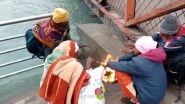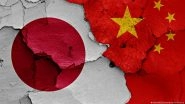Washington D.C. [USA], Sept 14 (ANI): Researchers have created a material, which they claim to be "10 times blacker than anything" with carbon nanotubes.The material is made from vertically aligned carbon nanotubes, or CNTs -- microscopic filaments of carbon, like a fuzzy forest of tiny trees, that the team grew on a surface of chlorine-etched aluminium foil.The foil captured more than 99.96 per cent of any incoming light, making it the blackest material on record.The researchers have published their findings in the journal, 'ACS-Applied Materials and Interfaces'.The artwork, a collaboration between Brian Wardle, professor of aeronautics and astronautics at MIT, and his group, and MIT artist-in-residence Diemut Strebe featured a 16.78-carat natural yellow diamond, estimated to be worth $2 million, which the team coated with the new, ultra-black CNT material.Wardle said the CNT material, aside from making an artistic statement, may also be of practical use, for instance in optical blinders that reduce unwanted glare, to help space telescopes spot orbiting exoplanets."There are optical and space science applications for very black materials, and of course, artists have been interested in black, going back well before the Renaissance," Wardle said. "Our material is 10 times blacker than anything that's ever been reported, but I think the blackest black is a constantly moving target. Someone will find a blacker material, and eventually, we'll understand all the underlying mechanisms, and will be able to properly engineer the ultimate black."Wardle and co-author Kehang Cui, who is now a professor at Shanghai Jiao Tong University, didn't intend to engineer an ultra-black material. Instead, they were experimenting with ways to grow carbon nanotubes on electrically conducting materials such as aluminium, to boost their electrical and thermal properties.But in attempting to grow CNTs on aluminium, Cui ran up against a barrier, literally: an ever-present layer of oxide that coats aluminium when it is exposed to air.This oxide layer acts as an insulator, blocking rather than conducting electricity and heat. As he cast about for ways to remove aluminium's oxide layer, Cui found a solution in salt, or sodium chloride.At the time, Wardle's group was using salt and other pantry products, such as baking soda and detergent, to grow carbon nanotubes.In their tests with salt, Cui noticed that chloride ions were eating away at aluminium's surface and dissolving its oxide layer."This etching process is common for many metals," Cui said. "For instance, ships suffer from corrosion of chlorine-based ocean water. Now we're using this process to our advantage."Cui found that if he soaked aluminium foil in saltwater, he could remove the oxide layer. He then transferred the foil to an oxygen-free environment to prevent reoxidation, and finally, placed the etched aluminium in an oven, where the group carried out techniques to grow carbon nanotubes via a process called chemical vapour deposition.By removing the oxide layer, the researchers were able to grow carbon nanotubes on aluminium, at much lower temperatures than they otherwise would, by about 100 degrees Celsius.They also saw that the combination of CNTs on aluminium significantly enhanced the material's thermal and electrical properties -- a finding that they expected.What surprised them was the material's colour."I remember noticing how black it was before growing carbon nanotubes on it, and then after growth, it looked even darker," Cui recalled. "So I thought I should measure the optical reflectance of the sample."Our group does not usually focus on optical properties of materials, but this work was going on at the same time as our art-science collaborations with Diemut, so art influenced science in this case," said Wardle.Cui measured the amount of light reflected by the material, not just from directly overhead, but also from every other possible angle.The results showed that the material absorbed greater than 99.995 per cent of incoming light, from every angle.In essence, if the material contained bumps or ridges, or features of any kind, no matter what angle it was viewed from, these features would be invisible, obscured in a void of black. (ANI)
(The above story is verified and authored by ANI staff, ANI is South Asia's leading multimedia news agency with over 100 bureaus in India, South Asia and across the globe. ANI brings the latest news on Politics and Current Affairs in India & around the World, Sports, Health, Fitness, Entertainment, & News. The views appearing in the above post do not reflect the opinions of LatestLY)













 Quickly
Quickly


